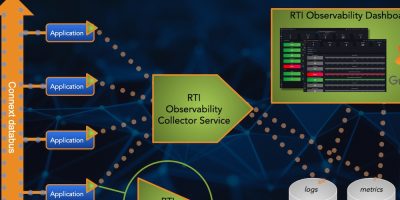Real-Time Innovations introduces observability framework
To maximise the performance and availability of intelligent systems, Real-Time Innovations (RTI) has introduced the Connext Observability Framework which allows operators to identify, understand and prevent obstacles encountered during deployment.
The software for autonomous systems announced the latest addition to its Connext product suite featuring the Connext Observability Framework. The Observability Framework is believed to be the first for operational technology systems based on the DDS (Data Distribution Service) standard.
According to Connext, developers and operators of mission-critical distributed applications such as in-hospital patient monitoring and remote vehicle operation will benefit from increased visibility into the health of deployed systems.
Autonomous applications require high reliability and real time performance that the underlying network may not always provide. The Observability Framework is the latest in the Connext Product Suite, offering visibility into systems’ run time behaviour, allowing potential problems to be identified before they impact the user. It also shortens the time required to diagnose and resolve issues when they do occur. This is particularly critical for systems deployed over networks that may be unreliable or have unpredictable bandwidth and latency, such as shared, wireless and public networks.
The Connext Observability Framework integrates with standard full stack observability components allowing developers to monitor Connext and non-Connext technologies with the same observability tools (including Prometheus for metrics storage, Grafana Loki for logs aggregation and Grafana dashboards for visualisation).
It allows users to monitor the performance and health of the distributed system from a holistic, centralised view and reduce system downtime by identifying and localising problems.
It also increases the quality and speed of design, development, testing and deployment through enhanced system verification and validation, said RTI.
Users can scale the observability telemetry pipeline as systems get more complex, added RTI.
“An increasing number of mission-critical applications are integrating autonomous capabilities. As these systems grow in scale and complexity, more data is exchanged leading to more dependence on unpredictable networks,” said David Barnett, vice president of product and markets at RTI. “We created the Connext Observability Framework so developers can have full confidence that their systems are working properly and that they can quickly diagnose and resolve issues when they are not.
“From medical devices to autonomous vehicles, mobile defence systems and beyond, this is another example of RTI leading the charge to the software-defined future,” he added.
Systems that can benefit from the Observability Framework include patient monitoring in a hospital, in which networks may be shared with other applications and bandwidth can vary as patients move. It is also suitable for the operation of autonomous vehicles at a mining site and command, control and communication in mobile defence systems.
The Connext Observability Framework is available with Connext 7.1, the latest release of the Connext Product Suite.




